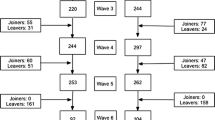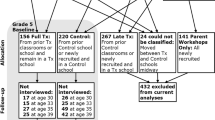Abstract
The effects of a school-based social-emotional and character development program, Positive Action, on the developmental trajectory of social-emotional and character-related behaviors was evaluated using data from three school-based randomized trials in elementary schools. Results come from 1) 4 years of data from students in 20 Hawai’i schools, 2) 3 years of data from students in 14 schools in Chicago and 3) 3 years of data from students in 8 schools in a southeastern state. Random intercept, multilevel, growth-curve analyses showed that students in both control and Positive Action schools exhibited a general decline in the number of positive behaviors associated with social-emotional and character development that were endorsed. However, the Positive Action intervention significantly reduced these declines in all three trials. Taken together, these analyses 1) give insight into the normative trajectory of behaviors associated with social-emotional and character development and 2) provide evidence for the effectiveness of Positive Action in helping children maintain a relatively beneficial developmental trajectory.

Similar content being viewed by others
References
Beets, M. W., Flay, B. R., Vuchinich, S., Snyder, F. J., Acock, A., Li, K. K., et al. (2009). Use of a social and character development program to prevent substance use, violent behaviors, and sexual activity among elementary-school students in Hawaii. American Journal of Public Health, 99, 1438–1445.
Benninga, J. S., Berkowitz, M. W., Kuehn, P., & Smith, K. (2006). Character and academics: What good schools do. Phi Delta Kappan, 87, 448–452.
Berkowitz, M. W., & Bier, M. C. (2004). Research-based character education. The Annals of the American Academy of Political and Social Science, 591(1), 72–85.
Bronfenbrenner, U., & Morris, P. A. (2006). The bioecological model of human development. In W. Damon & R. M. Lerner (Series Eds & Vol. Eds.), Handbook of child psychology Vol 1. Theoretical models of human development (6th ed., pp. 793–828). New York: Wiley.
Brown, C. H., Wang, W., Kellam, S. G., Muthén, B. O., Petras, H., Toyinbo, P., et al. (2008). Methods for testing theory and evaluating impact in randomized field trials: Intent-to-treat analyses for integrating the perspectives of person, place, and time. Drug and Alcohol Dependence, 95, 74–104.
Carlo, G., Crockett, L. J., Randall, B. A., & Roesch, S. C. (2007). A latent growth curve analysis of prosocial behavior among rural adolescents. Journal of Research on Adolescence, 17, 301–324.
Catalano, R. F., Berglund, M. L., Ryan, J. A. M., Lonczak, H. S., & Hawkins, J. D. (2004). Positive youth development in the United States: Research findings on evaluations of positive youth development programs. Annals of the American Academy of Political and Social Science, 591, 98–124.
Catalano, R. F., Gavin, L. E., & Markham, C. M. (2010). Future directions for positive youth development as a strategy to promote adolescent sexual and reproductive health. Journal of Adolescent Health, 46, S92–S96.
Cohen, P., Cohen, J., Aiken, L. S., & West, S. G. (1999). The problem of units and the circumstance for POMP. Multivariate Behavioral Research, 34, 315–346.
Collaborative for Academic, Social, and Emotional Learning. (2003). Safe and sound: An educational leader’s guide to evidence-based social and emotional learning programs. Chicago, IL: Author.
Dent, C. W., Galaif, J., Sussman, S., Stacy, A., Burton, D., & Flay, B. R. (1993). Demographic, psychosocial and behavioral differences in samples of actively and passively consented adolescents. Addictive Behaviors, 18, 51–56.
DuBois, D. L., Ji, P., Flay, B. R., Day, J., & Silversthorn, N. (2010, June) Further validation of the youth social and character development scale. Poster session presented at the annual research conference of the Institute of Educational Sciences, Washington, DC.
Eisenberg, N., Fabes, R. A., & Spinrad, T. L. (2006). Prosocial development. In W. Damon & R. M. Lerner (Series Eds.), N. Eisenberg (Vol. Ed.), Handbook of child psychology: Vol. 3. Social, emotional, and personality development (6th ed., pp. 646–718). New York: Wiley.
Eisenberg, N., & Morris, A. S. (2004). Moral cognitions and prosocial responding in adolescence. In R. M. Lerner & L. D. Steinberg (Eds.), Handbook of adolescent psychology (2nd ed., pp. 155–188). Hoboken, NJ: Wiley.
Elias, M. J. (2009). Social-emotional and character development and academics as a dual focus of educational policy. Education Policy, 23, 831–846.
Ferber, T., Gaines, E., & Goodman, C. (2005). Positive youth development: State strategies. Retrieved March 3, 2010 from http://www.ncsl.org/Portals/1/documents/cyf/final_positive_youth_development.pdf
Flay, B. R. (2002). Positive youth development requires comprehensive health promotion programs. American Journal of Health Behavior, 26, 407–424.
Flay, B. R., & Allred, C. G. (2003). Long‐term effects of the positive action program—a comprehensive, positive youth development program. American Journal of Health Behavior, 27, S6–S21.
Flay, B. R., & Allred, C. G. (2010). The Positive Action program: Improving academics, behavior and character by teaching comprehensive skills for successful learning and living. In T. Lovat & R. Toomey (Eds.), International research handbook on values education and student well-being (pp. 471–501). New York: Springer.
Flay, B. R., Allred, C. G., & Ordway, N. (2001). Effects of the positive action program on achievement and discipline: Two matched-control comparisons. Prevention Science, 2, 71–89.
Flay, B. R., Snyder, F. J., & Petraitis, J. (2009). The theory of triadic influence. In R. J. DiClemente, R. A. Crosby, & M. Kegler (Eds.), Emerging theories in health promotion practice and research (2nd ed., pp. 451–510). San Francisco: Jossey-Bass.
Ji, P. Y., DuBois, D. L., Flay, B. R., & Brechling, V. (2008). “Congratulations, you have been randomized into the control group!(?)”: Issues to consider when recruiting schools for matched-pair randomized control trials of prevention programs. Journal of School Health, 78, 131–139.
Kokko, K., Tremblay, R. E., Lacourse, E., Nagin, D. S., & Vitaro, F. (2006). Trajectories of prosocial behavior and physical aggression in middle childhood: Links to adolescent school dropout and physical violence. Journal of Research on Adolescence, 16, 403–428.
Lerner, R. M., Almerigi, J. B., Theokas, C., & Lerner, J. V. (2005). Positive youth development: A view of the issues. Journal of Early Adolescence, 25, 10–16.
Li, K.-K., Washburn, I., DuBois, D. L., Vuchinich, S., Ji, P., Brechling, V., et al. (2011). Effects of the Positive Action program on problem behaviors in elementary school students: A matched-pair randomized control trial in Chicago. Psychology & Health, 26, 187–204.
Nantel-Vivier, A., Kokko, K., Caprara, G. V., Pastorelli, C., Gerbino, M. G., Paciello, M., et al. (2009). Prosocial development from childhood to adolescence: A multi-informant perspective with Canadian and Italian longitudinal studies. Journal of Child Psychology and Psychiatry and Allied Disciplines, 50, 590–598.
Park, N. (2004). Character strengths and positive youth development. The ANNALS of the American Academy of Political and Social Science, 591, 40–54.
Phelps, E., Zimmerman, S., Warren, A., Jelicic, H., von Eye, A., & Lerner, R. M. (2009). The structure and developmental course of positive youth development (PYD) in early adolescence: Implications for theory and practice. Journal of Applied Developmental Psychology, 30(5), 571–584.
Purkey, W., & Novak, J. (1984). Inviting school success: A self-concept approach to teaching and learning. Belmont, CA: Wadsworth.
Rabe-Hesketh, S., & Skrondal, A. (2008). Multilevel and longitudinal modeling using Stata. College Station, TX: Stata Press.
Segawa, E., Ngwe, J. E., Li, Y., & Flay, B. R. (2005). Evaluation of the effects of the Aban Aya Youth Project in reducing violence among African American adolescent males using latent class growth mixture modeling techniques. Evaluation Review, 29, 128–148.
Snyder, F., Flay, B., Vuchinich, S., Acock, A., Washburn, I., Beets, M., et al. (2010). Impact of a social-emotional and character development program on school-level indicators of academic achievement, absenteeism, and disciplinary outcomes: A matched-pair, cluster-randomized, controlled trial. Journal of Research on Educational Effectiveness, 3, 26–55.
Tufts University, Intitute for Applied Research in Youth Development. (2008). The 4‐H study of positive youth development: Report of the findings from the first four waves of data collection: 2002–2003, 2003–2004, 2004–2005, and 2005–2006. Retrieved March 3, 2010 from http://ase.tufts.edu/iaryd/documents/4HStudyAnnualReport2008.pdf
Wiesner, M., Capaldi, D. M., & Patterson, G. R. (2007). Development of antisocial behavior and crime across the life-span from a social interactional perspective: The coercion modell. In R. L. Akers & G. F. Jensen (Eds.), Social learning theory and the explanation of crime: A guide for the new century (pp. 317–338). New Brunswick, NJ: Transaction.
Acknowledgments
This project was funded by the National Institute on Drug Abuse (R01-DA13474), the Institute of Education Sciences (R305L030072) and the Department of Education (Partnerships in Character Education grants). Additionally, the National Institute on Drug Abuse (DA018760) provided financial support for the completion of the work on this manuscript. The authors would like to thankfully recognize the support and involvement of the Hawai’i, Chicago and Southeastern State school districts and the principals, administrators, teachers, staff, students and their families at the participating schools. We also thank Howard Humphreys and Jonathan Wang for help with data collection and management in the Hawai’i dataset.
Conflict of interest
The research described herein was done using the program and the training and technical support of Positive Action, Inc. Dr. Flay’s spouse holds a significant financial interest in Positive Action, Inc.
Author information
Authors and Affiliations
Corresponding author
Rights and permissions
About this article
Cite this article
Washburn, I.J., Acock, A., Vuchinich, S. et al. Effects of a Social-Emotional and Character Development Program on the Trajectory of Behaviors Associated with Social-Emotional and Character Development: Findings from Three Randomized Trials. Prev Sci 12, 314–323 (2011). https://doi.org/10.1007/s11121-011-0230-9
Published:
Issue Date:
DOI: https://doi.org/10.1007/s11121-011-0230-9




